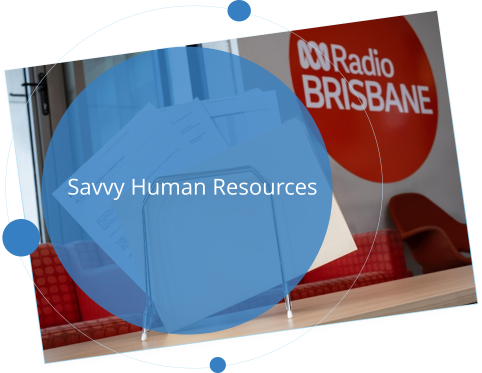 Since 2018, Craig McFadden(Managing Director of Savvy HR) has been a trusted voice on workplace issues, regularly appearing on ABC Radio Brisbane to provide expert insights. His commentary has covered topics such as the Secure Jobs, Better Pay bill, effective consultation during restructures, ‘job washing,’ pay secrecy clauses, and remuneration reviews. Most recently, Craig joined journalist Ellen Fanning on ABC Radio Brisbane to explore the evolving role of AI in recruitment—a conversation that delves into both the opportunities and challenges this technology presents for modern workplaces.
Since 2018, Craig McFadden(Managing Director of Savvy HR) has been a trusted voice on workplace issues, regularly appearing on ABC Radio Brisbane to provide expert insights. His commentary has covered topics such as the Secure Jobs, Better Pay bill, effective consultation during restructures, ‘job washing,’ pay secrecy clauses, and remuneration reviews. Most recently, Craig joined journalist Ellen Fanning on ABC Radio Brisbane to explore the evolving role of AI in recruitment—a conversation that delves into both the opportunities and challenges this technology presents for modern workplaces.
The Rise of AI in Recruitment: Balancing Efficiency, Fairness, and Merit
The use of AI in recruitment has steadily gained momentum. Tasks that once relied on human judgment—like screening resumes and conducting initial interviews—are increasingly automated. AI-powered tools are helping employers sift through vast amounts of data, identify potential candidates, and streamline hiring processes. For businesses, this means faster decisions, reduced costs, and fewer risks of making the wrong hire.
But as with any innovation, AI in recruitment comes with challenges. While it promises efficiency and accuracy, it also raises questions about fairness and whether merit is truly upheld.
In contingent recruiting, a widespread approach in competitive markets where recruiters only earn a fee if they place a candidate, speed often trumps depth. Recruiters, many from sales backgrounds rather than industry-specific expertise, work under intense pressure to find the “perfect fit” before their competitors—or even the hiring company itself.
AI has become a critical tool in this environment, automating repetitive tasks like:
- Talent Discovery: Identifying potential candidates who haven’t applied but meet job criteria.
- Resume Screening: Quickly matching qualifications to job requirements.
- Predictive Analytics: Assessing a candidate’s likelihood of success based on data.
- Pre-Screening: Conducting AI-powered video interviews to save time and resources.
While these tools can make recruitment more efficient, they also introduce risks. Poorly implemented AI systems may unintentionally perpetuate biases, eroding fairness and undermining merit-based hiring.
Modern Technologies: Innovative but Imperfect
AI is driving innovation across the recruitment industry. Contextual recruitment systems, video interviews, gamification, and even social media-driven assessments like TikTok videos are being used to attract and evaluate talent.
These tools are exciting but imperfect:
- Contextual Recruitment Systems mine demographic data to identify candidates from less privileged backgrounds. While this sounds great for diversity, it’s limited by the quality of available data and may overlook candidates whose challenges aren’t captured by algorithms.
- Video Interviews allow candidates to respond to pre-recorded questions at their convenience. However, AI may unfairly penalize those whose language or mannerisms reflect working-class or cultural backgrounds.
These innovations highlight the fine line between progress and unintended discrimination.
When AI Falls Short: Lessons from the Public Sector
Concerns about AI in recruitment aren’t hypothetical. Recent issues in Australia’s public sector highlight its pitfalls.
Australia’s Merit Protection Commissioner (MPC) issued guidance for employers in the public sector and overturned promotional decisions made by Services Australia after AI-assisted and automated selection processes overlooked highly qualified candidates.
These decisions relied on psychometric tests, questionnaires, and AI-analysed video responses—without human oversight. The lack of a human review panel led to unfair outcomes, undermining the process’s integrity and the candidates’ confidence in the system.
Research Highlights: Bias in AI Recruitment Tools
Dr. Angelo Capuano of Central Queensland University delved deeper into these issues in a study presented at the Australian Labour Law Association’s national conference. Testing major AI tools his research uncovered significant biases:
- Educational Bias: Candidates from prestigious private schools were favoured over public school graduates.
- Language Bias: Subtle non-standard English (NSE) features linked to working-class or racial identities were penalized.
- Disability Bias: Speech patterns associated with autism spectrum disorder or cultural norms, such as Australian Aboriginal English, were scored negatively.
While AI can reduce some forms of human bias, it risks reinforcing systemic inequities if not properly managed.
Striking the Right Balance
For employers, the key is not to abandon AI but to use it responsibly. Dr. Capuano recommends safeguards to mitigate risks while preserving AI’s benefits, including:
- Bias Mitigation Training for AI systems to recognize and avoid penalizing certain attributes.
- Regular Audits to identify and address biases in AI tools.
- Global Best Practices including regulations on AI in recruitment which mandate audits and transparency for employers and applicants.
Moving Forward
AI has enormous potential to improve recruitment. It can save time, uncover hidden talent, and help businesses make more informed hiring decisions. But these benefits shouldn’t come at the expense of fairness or equity.
Employers must ensure the technology they use doesn’t inadvertently exclude talented candidates based on their background, disability, or other protected attributes. Thoughtful implementation, regular reviews, and a commitment to transparency are essential to striking the right balance.
By approaching AI with care, employers can embrace innovation without compromising the integrity of their recruitment processes—or their workforce’s diversity.
Ref: "Investigating bias based on class, race and disability in ChatGPT and other Large Language Models: Is discrimination law in Australia equipped for the latest leap in AI?" by Dr. Angelo Capuano, presented at the Australian Labour Law Association national conference, Geelong, November 9, 2024.
 Disclaimer: This publication is provided in good faith by way of general guidance only to assist employers and their employees and is for information purposes only. It is not to be construed by the reader as legal advice or as a recommendation to take a particular course of action in the conduct of their business or personal affairs. The Information may be based on data supplied by third parties. We do not guarantee that the information in this article is accurate at the date it is received or that it will continue to be accurate in the future. You should not rely upon the material as a basis for action that may expose you to a legal liability, injury, loss or damage and it is recommended that you obtain your own advice relevant to your particular circumstances. Savvy Human Resources Associates Pty Ltd & SAVVYHR do not accept responsibility for any inaccuracy and is not liable for any loss or damages arising either directly or indirectly as a result of reliance on, use of or inability to use any information provided in this article
Disclaimer: This publication is provided in good faith by way of general guidance only to assist employers and their employees and is for information purposes only. It is not to be construed by the reader as legal advice or as a recommendation to take a particular course of action in the conduct of their business or personal affairs. The Information may be based on data supplied by third parties. We do not guarantee that the information in this article is accurate at the date it is received or that it will continue to be accurate in the future. You should not rely upon the material as a basis for action that may expose you to a legal liability, injury, loss or damage and it is recommended that you obtain your own advice relevant to your particular circumstances. Savvy Human Resources Associates Pty Ltd & SAVVYHR do not accept responsibility for any inaccuracy and is not liable for any loss or damages arising either directly or indirectly as a result of reliance on, use of or inability to use any information provided in this article







